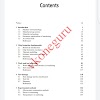HYDROGRAPHIC STANDARDS AND CLASSIFICATIONS
Introduction
The results from a hydrographic survey are normally plotted to produce a bathymetriccontour map, which is a plan of the depth of the sea bed arranged in such a manner as
to show lines of equal depth from the coastline. In a hydrographic survey, the actual
measurement of the water depth is the easy part. The main problem is not knowing
how far the survey boat is from the coastline when the depth is recorded.
Boat A in Figure 1, for example, has no point of reference in relation to the coast.
Boat B, on the other hand, is using a calibrated float line to obtain a “FIX” or position
with respect to the coastline; in this case, 20 metres away on the straight line between
the peg and the buoy. Hence, for each vertical depth recording, a horizontal position
“FIX” is also required. Both vertical depth measurements and horizontal position
measurements may be carried out either manually (low tech, low cost) or using
sophisticated depth and position fixing equipment (high tech, high cost), depending on
the end use of the survey.
Hydrographic surveys are required for a wide variety of purposes, ranging from
simple reconnaissance (at project formulation, for instance) to payment for work carried
out underwater, such as dredging or reclamation.
Click here to download Full NOTES on
HYDROGRAPHIC STANDARDS AND CLASSIFICATION
For more details regarding any issue you may mail us on vkoneguru@gmail.com
We Got Great Search Results For Your Query: Mechanical Engineer Degree. Click HereSTUDY materials for Gate, IES, UPSE &any university exam and Find Everything You Need.
Comments for any books with subject name and writter name...
We try to give you best..
For regular updates you must verify your email id...
Thanks
Please subscribe and follow us vkoneguru
You can search on Google also vkoneguru and follow us..








0 Comments